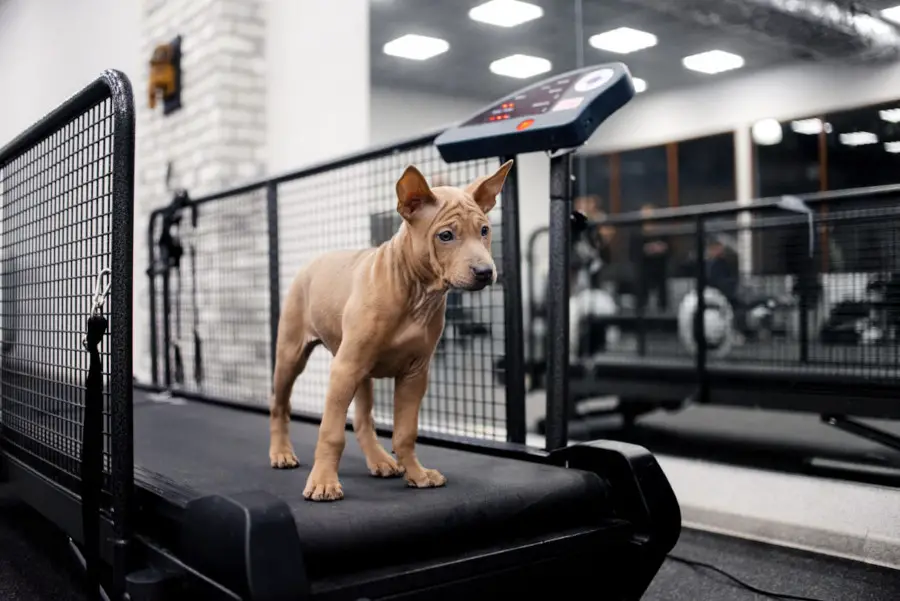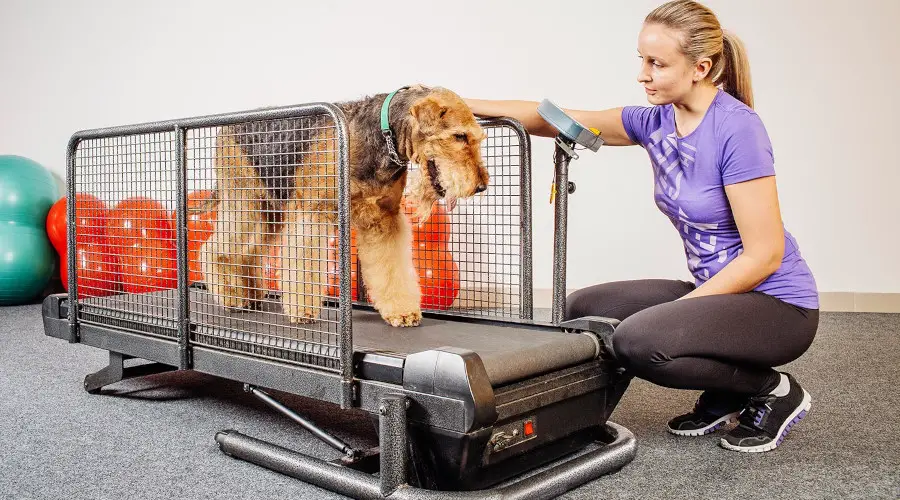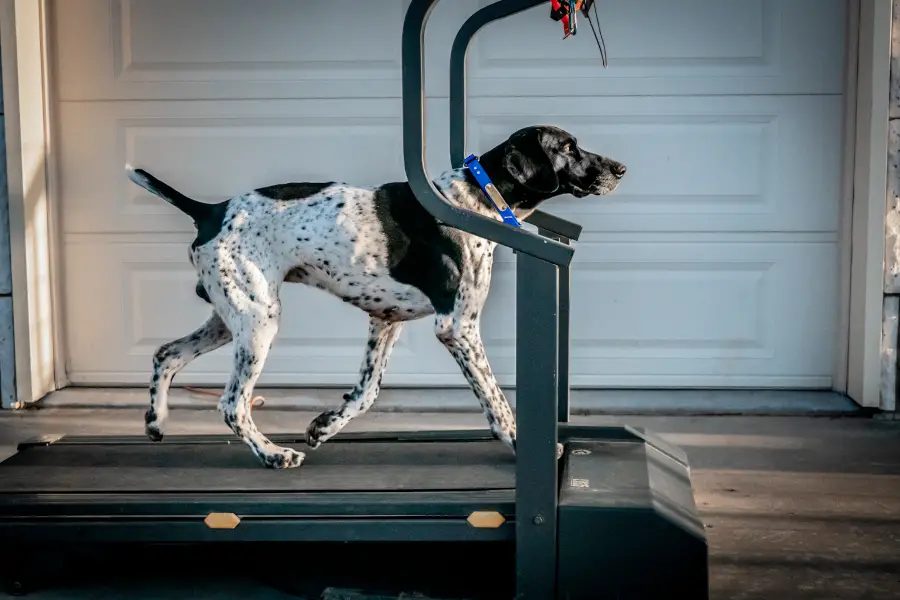Workout sessions are important to keep your dog healthy and energetic. Training your dog to run on a treadmill is an effective way of exercising.
It can prove very beneficial in terms of mental and physical health, retaining confidence, and sometimes reducing behavioural problems like barking, chewing, and other anxiety-related issues.
Table of Contents
How to Teach Your Dog to Walk on a Treadmill?
The process of training your dog to use a treadmill expands over many steps. It begins with familiarizing him with the treadmill.
Use the techniques of positive reinforcement to do so and train him to stand on the still-running pad.
Proceed by turning on the motor and have him run at a slow pace and gradually increase the intensity of the workout. For productive results, keep the training session short.
Step by Step Guide
Sometimes, taking your dog outside for a walk is not a good option. It might be raining, or it might be too cold.
Similarly, you might be too busy or under the weather, or with the current lockdown situation, there might be restrictions on going out.
A treadmill is just the thing your dog needs right now. Exercising on a treadmill is highly advantageous that can help your dog to lose weight and prevent obesity.
But does your dog fret about the treadmill machine? If that is the case, worry no more. Here are some simple and effective ways to teach your dog to use a treadmill with confidence and without any kind of hesitation.
Step 1: Introduce the Dog to the Treadmill
Your dog is new to the treadmill, so it is not just going to run towards it. He needs a proper incentive to do so.
Let him acquaint himself with the machine by sniffing and touching it. The second way is to spur him through a meal or his favorite toy.
Keep in mind to keep the machine off while doing so as the running motor might agitate him. Let him take his time to become used to it.
Step 2: Choose the Right Treadmill
There are various kinds of treadmills available for dogs, and it’s imperative that you choose the right one.
Special treadmills designed for animals are available. If you need the machine only for your dog, this might be the one you want.
These treadmills are preferable in the case of large-breed dogs as their stride might become short unnaturally on a treadmill designed for humans.
These treadmills are of two types; mechanical treadmills use motors but are specially designed for dogs, while dog-powered treadmills can be tread-wheels (giant hamster wheels for dogs) or dog carpet mills (made of wood, nails, and carpet).

Treadmills designed for human beings can also be used for training your dog. However, they can be a little discomforting to your dog because of:
Position of Motor
The position of the motor on a human treadmill is not placed keeping in mind a dog. So, it might prove fatal if the long fur of your dog gets stuck in it.
Noise and Vibrations
Treadmills designed for dogs are quieter and more stable as compared to those made for human beings. This might intimidate your dog.
Side Rails
This feature is common to both types of treadmills. But side rails in the case of animal treadmills are positioned much lower, making the treadmill safer for them.
Gaps Between Belt and Edges
This gap between the belt and edges is wide in human treadmills. So, there is always concern about the dog getting his claw stuck and injuring himself.
Step 3: Set an Example
Once your dog becomes used to the machine, start using the machine in front of him. Your dog trusts you, so when he sees you interacting with the treadmill, he will feel more comfortable with its presence.
Step 4: Setting Up the Treadmill
The position of the treadmill is important. It should not be facing the wall; otherwise, it might stress out your dog thinking that he is going to run into the wall.
Instead, place it in the middle of the room or a place that you know is your dog’s favorite.
Step 5: Make Your Dog walk on a Steady Treadmill
Now that your dog is familiar enough with the machine, it is time to get him on it. You can use meal treats for that. Here, an important thing to follow is the use of affirmative reinforcement.
Use verbal commands like ‘let’s go’ or ‘go on’ to appraise his behavior. Award him a treat for accomplishing each step.
This way, the next time you command him, he will do what you demand.
One way is to start with the dog on the treadmill and start the treadmill at its slowest speed.
The other way is to begin with the treadmill at the slowest pace and then introduce the dog to the moving treadmill. However, this involves trial and error since it might scare him off easily.
Divide the session into multiple rounds but always keep it brief enough to make your dog want more.
While following the process, it is important to keep your dog’s confidence in check. Avoid proceeding to the next step until your dog eases into the previous one. Take a week or so for each step.

Step 6: Slow but Steady
Now begins the real action! Once your dog knows the machine and is friendly with it, level up the challenge.
Begin with leashing up your dog. Then help him get on the machine with the leash in your hand. Light pressure with the leash forward and backwards will help your dog stabilize.
Turn the switch on at the lowest rate and stand in front of him, so he feels comfortable, and encourage him with treats.
The dog might adapt quickly, or he might become scared and resistant, depending on his nature. But do not give up yet.
Keep the pace slow. The session should not exceed more than 30 seconds to 1-minute intervals. Make him redundantly steady, but it’s important that you go slow.
Step 7: Synchronization
Note the pace at which your dog is going on the treadmill. This pace is different for different dogs.
The ideal pace calls for the synchronization of his left and right legs in a diagonal manner; the rear right and front left. This ensures natural balance and an efficient run.
Step 8: Use Positive Reinforcement
Throughout the training session, encourage your dog through positive reinforcement. Reward him the minute he follows your command correctly.
For instance, if you call “go on” and your dog climbs the treadmill, treat him with something he likes. To keep your dog running on the machine, lure him with a treat.
Reward him for his behavior since that will keep him on track. Once your dog gets accustomed to the slow speed, increase the speed gradually. Eventually, it will be trained for the best.
Step 9: Know When to Stop
An excess of anything can turn an advantage into a disadvantage. When you see that your dog is showing signs of distress and boredom, stop the session.
Try to read the body language of the dog throughout the training session and let him rest.
Step 10: Higher Speeds and Longer Periods
As you continue with the session, speed up the workout intensity. You can stretch the one-minute intervals now to intervals lasting 2-3 minutes and ultimately to 5 minutes.
A 30-minute session is what your dog requires every day, so you can continue to increase the period accordingly to reach the objective.
You can vary the speed and intensity of the workout depending on the dog’s fitness level. If he is overweight, you certainly need to strive for more workouts.
Once the training is done, it is going to be fun for your dog on the treadmill when he strides like a pro.

Step 11: Be Safe
For the well-being of your dog, do not feed him before working out. This can cause abdominal pain and cramping.
Conclusion
When it comes to training a dog to use the treadmill, we would first advise you to always attend to your dog and never leave it unsupervised. Hold the leash, do not let go of it and stand next to the treadmill.
Like any athlete, your dog needs time to cool down, too. Start with a slow workout and then gradually increase the intensity. In the end, decelerate again and allow him a 5 to 10-minute walk after a rigorous workout.
